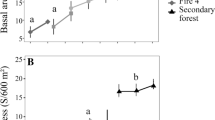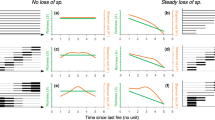Summary
Vegetation dynamics after fire was studied in six communities in Bas-Languedoc (Southern France). 47 plots were observed by means of a permanent transect for ten years.
In the first part, we describe floristic richness, species fugacity and the way by which, the ‘terminal’ community (as defined by the last observation) appears. The dynamics of all these communities follows a simple and general model: floristic richness reaches its maximum during the first two years after a fire, then decreases and becomes stable. Fugacity follows a similar model, whereas the mergence of the ‘terminal’ community is rapid: one year after fire 70% of the plots have already acquired 75% of the species of the ‘terminal’ community. There is no succession (in the general sense of the word), but a progressive reappearance of the species belonging to the original community.
In the second part, we study floristic similarities between our plots and corresponding associations as described in literature. It appears that after a fire the floristic diversity of the landscape remains high; while the communities rapidly reach a relative maturity.
In the study area fire seems to be a rather superficial phenomenon; it does not lead to an important modification of the community dynamics, because probably the most frequent species in Bas-Languedoc developed adaptations to withstand fire.
Similar content being viewed by others
References
Barry, J.P., 1960. Contribution à l'étude de la végétation de la région de Nimes. Année Biol. Bème série, 36: 311–550.
Bazzaz, F.A., 1968. Succession on abandoned fields in the Shawnee Hills, Southern Illinois. Ecology 49: 924–936.
Bazzaz, F.A., 1975. Plant species diversity in old field successional systems in Southern Illinois. Ecology 56: 485–488.
Bharucha, F.R., 1932. Etude écologique et phytosociologique de l'association à Brachypodium ramosum et Phlomis lychnitis. Comm. SIGMA. 18, Bcihefte Bot. Centralb. 1933, 2: 247–379.
Biswell, H.H., 1963. Research in wildland fire ecology in California. Ann. Tall Timbers Fire Ecol. Conf. Proc. 2: 63–97.
Biswell, H.H., 1974. Effects of fire on chaparral. In: Kozlowski & Ahlgren (eds.), Fire and ecosystems, p. 321–364 Acad. Press, New York.
Boesch D.F., 1974. Diversity, stability and response to human disturbance in estuarine ecosystems. Proc. 1st. Int. Congress Ecology. The Hague, Sept. 8–14, 1974: 109–114.
Bournerias M., 1959. Le peuplement végétal des espaces nus (essais expérimentaux sur la génèse de divers groupements pionniers). Mem. Bull. Soc. Bot. France, 300 pp.
Braun-Blanquet, G., 1936. La lande à Romarin et Bruyère (Rosmarino-Ericion) en Languedoc. Comm. Sigma 48: 8–23.
Braun-Blanquet J., 1936. La forêt d'yeuse languedocienne (Quercion Ilicis). Monographic phytosociologique. Mem. Soc. Etud. Sci. Nat. Nimes, 5, 147 pp.
Braun-Blanquet J., N., Roussine & R., Negre 1952. Les groupements végétaux de la France méditerranéenne. C.N.R.S. Ed. 297 pp.
Daget, P. & J.Poissonet. 1971. Une méthode d'analyse phytologique des prairies. Ann. Agron. 22: 5–41.
Dunn, J.C. 1974. A fuzzy relative of the Isodata process and its use in detecting compact well-separated clusters. J. Cybernetics 3: 32–57.
Fournier P. 1961. Les quatre flores de France. ed. P. Lechevallier, Paris, 1105 p.
Golley F.B. 1974. Structural and functional properties as they influence ecosystem stability. Proc. 1 st Intern. Congress. Ecology. The Hague, sept. 8–14, 1974: 97–102.
Goodman D. 1974. The validity of the diversity-stability hypothesis. Proc. Ist. Intern Congress Ecology. The Hague, sept. 8–14, 1974: 75–79.
Guillerm, J.L. 1978. Sur les états de transition dans les phytocénoses post-culturales. These Doc. Etat, USTL. Montpellier, 128 pp.
Hanes, T.L. 1971. Suecession after fire in the chaparral of Southern California. Ecol. Monogr. 41: 27–52.
Hanes, T.L. & H.W.Jones. 1967. Postfire chaparral succession in Southern California. Ecology: 48: 259–264.
Harper, J.L. 1977. Population biology of plants. Academic Press, New York, 892 pp.
Holling, C.S. 1973. Resilience and stability of ecological systems. Ann. Rev. Ecol. Syst. 4: 1–23.
Horton, J.S. & C.J.Kraebel. 1955. Development of vegetation after fire in the chamise chaparral of Southern California. Ecology. 36: 244–262.
Kornas, J. 1958. Succession régressive de la végétation de garrigue sur calcaires compacts dans la Montagne de la Gardiole près de Montpellier. Acta Soc. Bot. Pol., 27: 563–596.
Kuhnholtz-Lordat, G., 1938. La terre incendiée. Essai d'agronomic comparée. ed. La Maison Carrée, Nimes, 361 pp.
Kuhnholtz-Lordat, G. 1958. L'écran vert. Mem. Mus. Nat. Hist. Natur., série B. Botanique, 9: 276 pp.
LeHouérou, H.N. 1974. Fire and vegetation in the mediterrancan basin. Ann. Tall. Timbers Fire Ecol. Conf. Proc. 13: 237–277.
Le Houérou, H.N. 1977. Fire and vegetation in North Africa. Proc. Symp. Environ. Consequences of Fire & Fuel Manag. in Medit. Ecosystems. Palo Alto, Calif., August 1–5, 334–341.
Levy, E. & E.Madden. 1933. The point method of pasture analysis. New. Zeal. J. Agr., 46: 267–279.
Lewontin, R.C. 1969. The meaning of stability. Brookhaven Symp. Biol. 22: 13–24.
Long, G. 1957. La ‘3 Step method’. Description sommaire et possibilités d'utilisation pour l'observation permanente de la végétation. Bull. Serv. Carte Phytogéogr. B. 2: 35–43.
Long, G. 1958. Description d'une méthode linéaire pour l'étude de l'évolution de la végétation. Bull. Serv. Carte Phytogéogr. B. 3: 107–128.
Margalef, R. 1969. Diversity and stability. A practical proposal for a model of interdependance. Brookhaven Symp. Biol. 22: 25–37.
Mellinger, M.V. & S.J.Me Naughton. 1975. Structure and function of successional vascular plant communities in Central New York. Ecol. Monographs 45: 161–182.
Naveh, Z. 1974a. The ecology of fire in Israel. Ann. Tall Timbers Fire Ecol. Conf. Proc. 13: 131–170.
Naveh, Z. 1974b. Effects of fire in the mediterranean region. In: Kozlowski & Ahlgren (eds.), Fire and ecosystems, p. 321–364 Acad. Press, New York.
Naveh, Z. 1975. The evolutionary significance of fire in the mediterranean region. Vegetatio, 29: 199–208.
Naveh, Z. 1977. The role of fire in the mediterranean landscape of Israel. Proc. Symp. Environ. Consequences Fire, Fuel Manage in Medit. Ecosystems, Palo Alto, Calif. August 1–5, 299–306.
Orians, G.H. 1974. Diversity, stability and maturity in natural ecosystems. Proc. Ist Intern. Congress Ecol., The Hague, Sept. 8–14, 1974: 64–65.
Patric, J.H. & T.L.Hanes. 1964. Chaparral succession in a San Gabriel Mountain area of California. Ecology, 45: 353–360.
Pavillard, J. 1935. Eléments de sociologie végétale. Act. Scient. Indust., 251: 102 p. Herman et Cie, Paris.
Sampson, A.W. 1944. Plant succession on burned chaparral lands in northern California. Bull. no. 685. California Agr. Exp. Sta., Berkeley, 144 pp.
Soroceanu, E. 1936. Recherches phytosociologiques sur les pelouses mésoxérophiles de la plaine langue docienne (Brachypodietum phoenicoïdis). Comm. SIGMA 40, 250 pp.
Stone, E.C. & G.Juhren. 1951. The effect of fire on the germination of the seed of Rhus ovata. Amer. J. Bot. 38: 368–372.
Sweeney, J.R. 1956. Responses of vegetation to fire. A study of the herbaceous vegetation following chaparral fires. Bot. Publ. Univ. Calif. 28: no. 4: 143–250.
Sweeney, J.R. 1967. Ecology of some ‘fire type’ vegetation in northern California. California Tall Timbers Fire Ecol. Conf. Proc. 7: 110–125.
Vogl, R.J. & P.K. 1972. Fire and manzanita chaparral in the San Jacinto mountains, California. Ecology 53: 1179–1188.
Author information
Authors and Affiliations
Rights and permissions
About this article
Cite this article
Trabaud, L., Lepart, J. Diversity and stability in garrigue ecosystems after fire. Vegetatio 43, 49–57 (1980). https://doi.org/10.1007/BF00121017
Accepted:
Issue Date:
DOI: https://doi.org/10.1007/BF00121017




